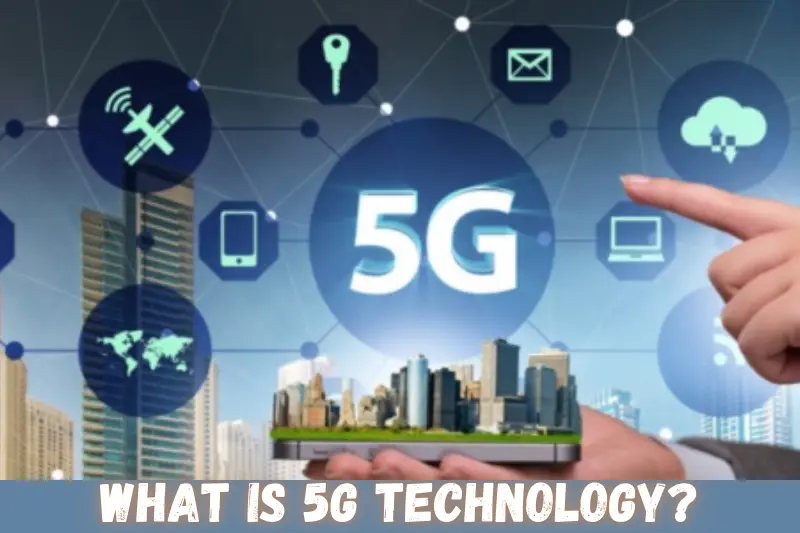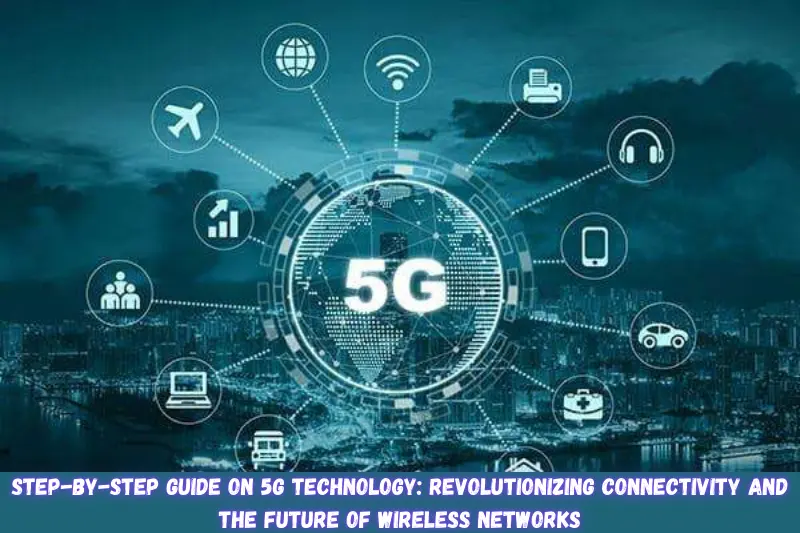Introduction:
In today’s fast-paced digital world, staying connected is more important than ever. 5G Technology: Revolutionizing Connectivity And The Future Of Wireless Networks is changing the way we use the internet, making everything faster, smarter, and more efficient. With ultra-fast speeds, near-instant response times, and the ability to connect millions of devices at once, 5G is set to transform industries like healthcare, smart cities, autonomous vehicles, and entertainment. But what exactly is 5G, and how will it impact our daily lives? In this blog post, we’ll explore how 5G is reshaping the future of wireless networks and unlocking endless possibilities.
What is 5G Technology?

5G Technology: Revolutionizing Connectivity And The Future Of Wireless Networks refers to the latest generation of mobile networks that is faster, more reliable, and more advanced than ever before. It is designed to provide:
- Lightning-fast internet speeds (up to 10 Gbps)
- Ultra-low latency (as low as 1 millisecond) for real-time communication
- Massive device connectivity, supporting smart cities, IoT, and automation
Unlike previous generations (like 4G), 5G operates on higher frequency bands and uses new technologies such as Massive MIMO, beamforming, and network slicing to enhance performance. This means seamless streaming, faster downloads, and smoother online experiences for everyone.
5G is not just an upgrade—it is a game-changer that will power the future of autonomous vehicles, telemedicine, smart factories, and much more. As more countries and industries adopt 5G, we can expect a world that is more connected, efficient, and innovative than ever before.
You May Also Like It:
The Best Smart Home Devices: Top Gadgets For A Smarter Living Space
Smart Home Security Systems: Top Solutions For A Safer Home In 2025
Best Wireless Charging Pads: Fast And Efficient Charging Solutions
Why is 5G Technology Important?
5G Technology: Revolutionizing Connectivity And The Future Of Wireless Networks is more than just a faster internet connection—it is a transformative technology that will shape the future of communication, business, and daily life. Here’s why 5G is so important:
Ultra-Fast Internet Speeds
- 5G offers speeds up to 10 Gbps, making it 100 times faster than 4G.
- Users can download large files, stream 4K/8K videos, and play online games with zero buffering.
- Faster internet means more productivity and better user experiences.
Low Latency for Real-Time Applications
- Latency (the delay in data transfer) is reduced to as low as 1 millisecond.
- This is essential for autonomous vehicles, remote surgeries, and real-time cloud gaming.
- Industries that rely on instant communication, such as finance and healthcare, will benefit greatly.
Supports the Growth of IoT (Internet of Things)
- 5G can handle millions of connected devices at the same time.
- Enables smart cities, automated homes, and industrial automation.
- Improves the efficiency of traffic management, energy grids, and smart appliances.
Revolutionizes Healthcare and Telemedicine
- Doctors can perform remote surgeries using robotic technology.
- Patients can receive real-time health monitoring with wearable devices.
- Increases access to healthcare in rural and remote areas.
Drives Innovation in Industries
- Manufacturing: Smart factories with AI-powered automation.
- Education: Enhanced virtual and augmented reality learning.
- Retail: Faster and more reliable online shopping experiences.
Enhances Autonomous Vehicles and Smart Transportation
- Enables real-time data exchange between vehicles for safer roads.
- Reduces accidents by allowing cars to communicate instantly with traffic signals and other vehicles.
- Improves public transportation systems through real-time tracking.
Strengthens Network Capacity and Reliability
- 5G provides stronger, more stable connections even in crowded areas.
- No more network congestion during large events or in busy cities.
- Helps businesses and individuals stay connected without interruptions.
Step-by-Step Guide on 5G Technology: Revolutionizing Connectivity And The Future Of Wireless Networks

5G technology is transforming the way we connect and interact with the digital world. This step-by-step guide will help you understand how 5G works, its benefits, and its impact on various industries.
Step 1: Understanding What 5G Technology Is
Before diving into its applications, it is important to understand what 5G technology is.
- 5G stands for fifth-generation wireless network technology.
- It is designed to be faster, more reliable, and more efficient than previous networks like 4G LTE.
- 5G operates on higher frequency bands and uses technologies like Massive MIMO, beamforming, and network slicing to improve performance.
Step 2: Learning How 5G Works
5G improves network performance by utilizing advanced wireless technologies.
- Higher Frequency Bands: 5G operates on millimeter waves (mmWave), allowing faster data transmission.
- Massive MIMO: Increases data capacity by using multiple antennas to send and receive signals simultaneously.
- Network Slicing: Divides the network into customized virtual slices, each optimized for different use cases like gaming, healthcare, or industrial automation.
- Edge Computing: Brings data processing closer to users, reducing latency and improving response times.
Step 3: Exploring the Key Benefits of 5G
5G technology offers several major improvements over previous generations.
- Ultra-Fast Speeds: Up to 10 Gbps, making downloads and streaming seamless.
- Low Latency: Reduced to as low as 1 millisecond, essential for real-time applications.
- Massive Connectivity: Can handle millions of devices at once, making it ideal for IoT applications.
- Improved Network Efficiency: Reduces congestion and provides stable connections even in crowded areas.
Step 4: Understanding the Impact of 5G on Different Industries
5G is revolutionizing multiple industries by enabling new technologies and efficiencies.
- Healthcare: Enables remote surgeries, real-time patient monitoring, and AI-driven diagnostics.
- Smart Cities: Supports traffic management, smart grids, and automated waste management.
- Autonomous Vehicles: Improves vehicle-to-vehicle (V2V) and vehicle-to-infrastructure (V2I) communication for safer roads.
- Manufacturing: Powers smart factories with AI automation and robotics.
- Education: Enhances e-learning with virtual and augmented reality applications.
Step 5: Identifying Challenges and Limitations of 5G
Despite its benefits, 5G technology also has some challenges.
- Infrastructure Costs: Requires new cell towers, fiber networks, and advanced hardware.
- Limited Coverage: Initial rollouts focus on urban areas, leaving rural regions behind.
- Security Concerns: More connected devices mean higher cybersecurity risks.
- Device Compatibility: Older smartphones and IoT devices may not support 5G networks.
Step 6: Preparing for the Future of 5G and Beyond
The future of 5G is promising, with advancements already underway for 6G networks.
- Expanding 5G Coverage: Governments and telecom companies are working to bring 5G to more regions.
- Developing AI-Powered Networks: AI integration will further optimize 5G performance.
- Advancements in IoT: More smart devices will benefit from 5G’s enhanced connectivity.
- 6G Development: Research on next-generation networks is already in progress, aiming for even higher speeds and lower latency.
Advantages and Disadvantages of 5G Technology
5G Technology: Revolutionizing Connectivity And The Future Of Wireless Networks is transforming how we connect and interact with technology. However, like any new innovation, it comes with both benefits and challenges. Below is a breakdown of the advantages and disadvantages of 5G.
Advantages of 5G Technology
| Ultra-Fast Internet Speeds 5G offers speeds up to 10 Gbps, which is 100 times faster than 4G LTE. Users can download HD movies in seconds and stream 4K/8K videos without buffering. Faster internet enhances productivity and user experience. |
| Low Latency for Real-Time Applications 5G reduces latency to as low as 1 millisecond, compared to 50ms on 4G. Essential for autonomous vehicles, online gaming, remote surgeries, and AI applications. Enables smooth cloud computing and real-time data processing. |
| Supports a Massive Number of Devices Can handle millions of devices per square kilometer. Ideal for IoT (Internet of Things), smart homes, and smart cities. Improves communication between connected devices, such as traffic systems and healthcare monitors. |
| Improved Network Efficiency and Reliability Uses network slicing to create customized networks for different industries. Provides a stable connection even in high-traffic areas like concerts or stadiums. Reduces network congestion during peak hours. |
| Revolutionizes Industries and Smart Cities Healthcare: Enables remote surgeries, AI-assisted diagnoses, and real-time patient monitoring. Manufacturing: Supports automation, robotics, and AI-driven production lines. Transportation: Enhances autonomous vehicles and smart traffic management systems. Education: Facilitates immersive learning through AR and VR technologies. |
Disadvantages of 5G Technology
| High Infrastructure Costs Requires significant investment in new cell towers, fiber networks, and advanced hardware. Telecom companies need to upgrade existing infrastructure, which can be expensive. Deployment is slower in developing countries due to high costs. |
| Limited Coverage in Early Stages 5G networks are currently available only in select cities. Rural areas and small towns may experience delays in getting 5G coverage. High-frequency 5G signals have shorter range and require more cell towers for better coverage. |
| Security and Privacy Risks More connected devices mean higher chances of cyber threats and data breaches. 5G’s reliance on software-driven networks increases vulnerabilities. Hacking risks in IoT applications (such as smart home systems) can pose safety concerns. |
| High Power Consumption 5G devices and networks consume more energy than previous generations. Increased data transfer rates require better battery optimization for mobile devices. More cell towers and servers lead to higher electricity usage. |
| Device Compatibility Issues Older smartphones and IoT devices do not support 5G networks. Users need to buy new 5G-compatible devices, which can be expensive. Not all regions have affordable 5G plans, making adoption slower. |
You May Also Like It:
Best Noise-Cancelling Headphones For Immersive Sound And Quiet Comfort
Best Fitness Trackers With Heart Rate Monitor | Top Picks And Reviews
Best MP3 Converter For YouTube – Fast And Free YouTube To MP3 Downloader
Frequently Asked Questions (FAQs) About 5G Technology
Here are some common questions and simple answers about 5G Technology: Revolutionizing Connectivity And The Future Of Wireless Networks to help you understand it better.
What is 5G technology?
5G is the fifth-generation wireless network that provides faster internet speeds, lower latency, and better connectivity compared to 4G. It is designed to support more devices and enable advanced technologies like smart cities, self-driving cars, and AI-powered applications.
How fast is 5G compared to 4G?
5G can be up to 100 times faster than 4G LTE, with speeds reaching 10 Gbps. This means you can download movies in seconds, stream 4K/8K videos without buffering, and experience smoother online gaming.
How does 5G work?
5G uses higher frequency radio waves and advanced technologies like Massive MIMO (multiple antennas), beamforming, and network slicing to improve speed, reduce delays, and handle more connected devices at once.
Is 5G available everywhere?
Not yet. 5G is currently being rolled out in major cities and urban areas, but rural areas may take longer to get full coverage. It requires new infrastructure, so expansion will take time.
Do I need a new phone to use 5G?
Yes. Older 4G phones cannot connect to 5G networks. To use 5G, you need a 5G-compatible smartphone or device. Many new models from brands like Samsung, Apple, and OnePlus support 5G.
Is 5G safe?
Yes, 5G is safe to use. It follows international safety guidelines for radiation exposure, just like previous wireless networks (4G, 3G). There is no scientific evidence that 5G harms health.
How will 5G improve gaming and streaming?
5G reduces lag (latency), allowing for smooth online gaming and live streaming. It also supports cloud gaming, so you can play high-quality games without needing a powerful gaming PC or console.
What industries will benefit the most from 5G?
Many industries will benefit from 5G, including:
Healthcare – Remote surgeries and real-time patient monitoring.
Smart Cities – Better traffic control, smart grids, and security systems.
Autonomous Vehicles – Faster and safer car-to-car communication.
Manufacturing – AI-powered automation and smart factories.
Education – Enhanced e-learning with VR and AR technology.
Does 5G use more battery on my phone?
Yes, 5G can use more battery because it processes more data at higher speeds. However, newer phones are designed with battery optimization features to improve efficiency.
What is the future of 5G?
5G will continue to expand and improve. It will lead to advancements in AI, smart homes, self-driving cars, and even 6G technology in the future. As infrastructure improves, more people will have access to 5G worldwide.
Conclusion:
5G Technology: Revolutionizing Connectivity And The Future Of Wireless Networks is transforming the way we connect, work, and experience the digital world. With super-fast speeds, low latency, and the ability to support millions of devices, 5G is set to power everything from smart cities and autonomous vehicles to remote healthcare and immersive gaming.
While there are challenges like infrastructure costs and security concerns, the benefits of 5G far outweigh the drawbacks. As the technology continues to grow, it will unlock new possibilities and shape the future of communication. If you’re considering switching to 5G, make sure you have a 5G-compatible device and check coverage in your area. The future of connectivity is here—and it’s faster than ever!
Bonus Points About 5G Technology
Here are some extra insights about 5G Technology: Revolutionizing Connectivity And The Future Of Wireless Networks that you might find interesting:
5G Can Enable Smart Homes and IoT
- 5G supports billions of connected devices, making smart homes more efficient.
- Your smart fridge, thermostat, security cameras, and appliances can communicate seamlessly.
5G Will Boost Augmented Reality (AR) and Virtual Reality (VR)
- Faster speeds and low latency will improve AR/VR experiences for gaming, education, and shopping.
- Imagine trying on clothes virtually before buying or attending VR concerts in real time.
5G and Self-Driving Cars
- Autonomous vehicles need real-time communication to function safely.
- 5G helps cars detect obstacles, communicate with traffic lights, and avoid accidents.
5G Can Help in Disaster Management
- During emergencies, 5G-powered drones and AI systems can assist in rescue operations.
- Faster communication can improve disaster response and coordination.
5G Could Make Wi-Fi Less Important
- With ultra-fast mobile networks, fewer people may rely on home Wi-Fi.
- Businesses and homes could switch to 5G for everyday internet use.
5G Will Open Doors to 6G in the Future
- As 5G evolves, researchers are already working on 6G networks.
- 6G is expected to bring even faster speeds, AI-driven connectivity, and better global coverage.
You May Also Like It:
Facebook Video Downloader – Download FB Videos In HD Free
Free Video Downloader | Fast And Easy Video Downloads
Word To PDF Converter | Fast, Free And Easy Online Conversion
Best YouTube To MP4 Converter | Fast And Free Online Video Download







